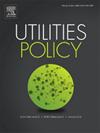覆盖范围之外:揭示智利在获得水和卫生服务方面的收入和空间不平等
IF 4.4
3区 经济学
Q3 ENERGY & FUELS
引用次数: 0
摘要
本研究考察了智利在获得饮用水和卫生设施方面与收入相关的不平等,重点关注城乡差距。利用CASEN家庭调查(1990-2017)的数据和集中度指数(CI)作为分配指标,分析揭示了持续的结构性不平等。获取不足不成比例地集中在低收入家庭,特别是在农村地区和非特许城市地区。虽然全国覆盖率有所提高,但这些成果并没有转化为公平的结果。在20世纪90年代和21世纪初,不平等加剧,尽管随后略有减少,但显著的差距仍然存在,特别是在获得改良水源方面。调查结果挑战了普遍的假设,即高国家覆盖率等同于普遍获得,揭示了总指标的局限性。该研究强调需要建立对公平敏感的监测系统和有地域差别的政策反应。政策必须超越目前农村地区的饮用水项目,以解决人口分散和基础设施限制的问题。在城市地区,将服务扩大到边缘化、非特许社区至关重要。解决这些不平等问题需要制度创新、参与式规划以及将社会公平纳入水治理框架。智利只有通过这些措施才能实现可持续发展目标6,并确保享有水和卫生设施的人权。本文章由计算机程序翻译,如有差异,请以英文原文为准。
Beyond coverage: Unveiling income and spatial inequalities in access to water and sanitation services in Chile
This study examines income-related inequalities in access to drinking water and sanitation in Chile, with a focus on urban-rural disparities. Using data from the CASEN household surveys (1990–2017) and the Concentration Index (CI) as a distributional measure, the analysis reveals persistent structural inequities. Access deficits are disproportionately concentrated among low-income households, particularly in rural areas and non-concessioned urban zones. While national coverage rates have improved, these gains have not translated into equitable outcomes. Inequality intensified during the 1990s and early 2000s, and although modest reductions followed, significant disparities persist, especially in access to improved sources. The findings challenge prevailing assumptions that high national coverage equates to universal access, revealing the limitations of aggregate indicators. The study underscores the need for equity-sensitive monitoring systems and territorially differentiated policy responses. Policy must go beyond the current potable water program in rural areas to address dispersed populations and infrastructure constraints. In urban areas, extending services to marginalized, non-concessioned neighborhoods is essential. Addressing these inequities requires institutional innovation, participatory planning, and the integration of social equity into water governance frameworks. Chile can only advance toward fulfilling SDG 6 and ensuring the human right to water and sanitation through such measures.
求助全文
通过发布文献求助,成功后即可免费获取论文全文。
去求助
来源期刊

Utilities Policy
ENERGY & FUELS-ENVIRONMENTAL SCIENCES
CiteScore
6.80
自引率
10.00%
发文量
94
审稿时长
66 days
期刊介绍:
Utilities Policy is deliberately international, interdisciplinary, and intersectoral. Articles address utility trends and issues in both developed and developing economies. Authors and reviewers come from various disciplines, including economics, political science, sociology, law, finance, accounting, management, and engineering. Areas of focus include the utility and network industries providing essential electricity, natural gas, water and wastewater, solid waste, communications, broadband, postal, and public transportation services.
Utilities Policy invites submissions that apply various quantitative and qualitative methods. Contributions are welcome from both established and emerging scholars as well as accomplished practitioners. Interdisciplinary, comparative, and applied works are encouraged. Submissions to the journal should have a clear focus on governance, performance, and/or analysis of public utilities with an aim toward informing the policymaking process and providing recommendations as appropriate. Relevant topics and issues include but are not limited to industry structures and ownership, market design and dynamics, economic development, resource planning, system modeling, accounting and finance, infrastructure investment, supply and demand efficiency, strategic management and productivity, network operations and integration, supply chains, adaptation and flexibility, service-quality standards, benchmarking and metrics, benefit-cost analysis, behavior and incentives, pricing and demand response, economic and environmental regulation, regulatory performance and impact, restructuring and deregulation, and policy institutions.
 求助内容:
求助内容: 应助结果提醒方式:
应助结果提醒方式:


